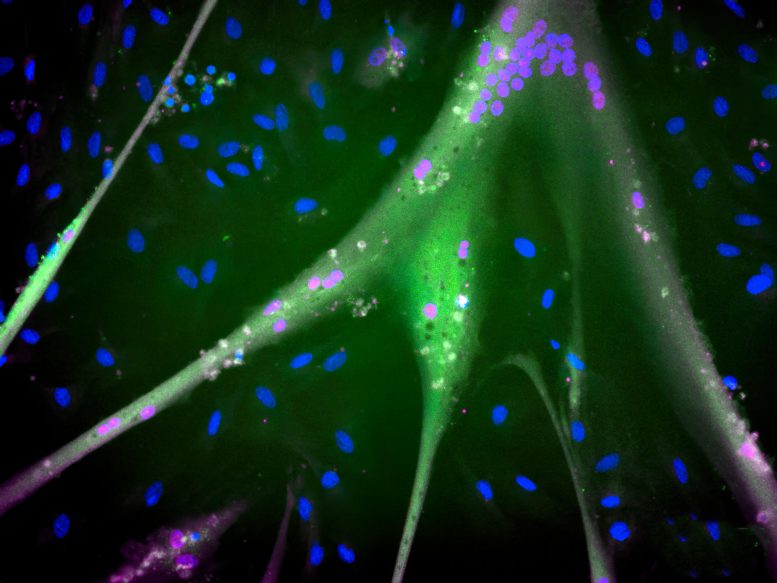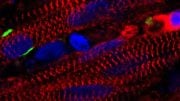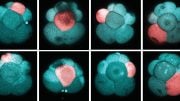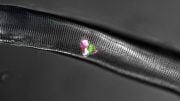
Differentiated immortalized bovine stem cells with fully expressed muscle proteins (blue = nuclei; magenta = myogenin; green = myosin). Scale approx 1 mm. Credit: Andrew Stout, Tufts University
Minimizing the necessity for animal biopsies, stem cells offer a potentially endless source for cultured meat.
For cellular agriculture—a technique that grows meat in bioreactors—to successfully feed millions, numerous technological hurdles must be conquered. The production of muscle cells from sources such as chicken, fish, cows, and more will need to increase to the point where millions of metric tons are yielded annually.
Researchers at the Tufts University Center for Cellular Agriculture (TUCCA) have made strides toward this objective by developing immortalized bovine muscle stem cells (iBSCs). These cells possess a rapid growth rate and the ability to divide hundreds of times, potentially even indefinitely, furthering the potential for large-scale meat production.
This advance, described in the journal ACS Synthetic Biology, means that researchers and companies around the globe can have access to and develop new products without having to source cells repeatedly from farm animal biopsies.
The production of cell-cultured meat will require muscle and fat cells with a very high capacity to grow and divide. While cell-grown meat has garnered media attention with examples such as the FDA preliminary approval of cultured chicken, and even a hamburger grown with mastodon DNA, the products are still expensive and difficult to scale up.
Normal muscle stem cells drawn from live animals to start a culture typically divide only about 50 times before they start to get “old” and are no longer viable. While it is theoretically possible for these stem cells to produce a substantial amount of meat, the immortalized cells developed by the TUCCA team offer several advantages. One is the possibility of producing significantly more mass for meat production.
Another advantage is that by making the immortalized cells widely available, they will lower the barrier of entry for other researchers to explore cellular agriculture — finding ways to reduce costs and overcome challenges to scaled-up production.
“Typically, researchers have had to do their own isolations of stem cells from animals, which is expensive and laborious, or use model cell lines from less relevant species, like mouse muscle cells,” said Andrew Stout, a graduate student at TUCCA and lead researcher on the project, “Using these new persistent bovine cell lines, their studies can be more relevant, literally getting right to the meat of the matter.”
Two steps were key to transforming regular bovine muscle stem cells into the immortalized bovine muscle stem cells. Most cells, as they divide and age, begin to lose DNA at the ends of their chromosomes, which are called telomeres, like worn ropes that get frayed with use. This can lead to errors when the DNA is being copied or repaired. It can also cause genes to be lost and, eventually, cells to die.
The researchers engineered the bovine stem cells to constantly rebuild their telomeres, effectively keeping their chromosomes “youthful” and ready for another round of replication and cell division.
The second step to immortalizing the cells was to make them continuously produce a protein that stimulates a critical stage of cell division. This effectively turbocharges the process and helps the cells to grow faster.
Muscle stem cells are not the final product that one wants to eat. They must not only divide and grow, but also differentiate into mature muscle cells just like, or at least very similar to, the muscle cells that we eat in a steak or fillet. Stout and his research team found that the new stem cells did indeed differentiate into mature muscle cells, although not entirely identical to animal muscle cells or muscle cells from conventional bovine stem cells.
“It’s possible that they are matured enough to replicate the flavor and texture of natural meat,” said Stout, “That’s something we will have to explore further. They are doubling at a very rapid rate, so they might just need a little more time to reach full maturity.”
“While some may question whether it is safe to ingest immortalized cells, in fact, by the time the cells have been harvested, stored, cooked, and digested, there is no viable path to continued growth,” said David Kaplan, Stern Family professor of biomedical engineering at Tufts and director of TUCCA. “Like natural meat we eat today, the cells simply become inert material that we hope will taste delicious and provide a wide range of nutritious benefits.”
Reference: “Immortalized Bovine Satellite Cells for Cultured Meat Applications” by Andrew J. Stout, Miles J. Arnett, Kristin Chai, Tina Guo, Lishu Liao, Addison B. Mirliani, Miriam L. Rittenberg, Michelle Shub, Eugene C. White, John S. K. Yuen Jr., Xiaoli Zhang and David L. Kaplan, 5 May 2023, ACS Synthetic Biology.
DOI: 10.1021/acssynbio.3c00216
The study was funded by the U.S. Department of Agriculture.









So they can immortalize bovine stem cells to make lab grown meat but they can’t keep humans from aging with stem cells? If we are supposed to eat that meat what’s the difference?
I don’t think the point is before humans live longer. Learn how to eat meat without torturing and killing other animals.
We can do a lot of things in tissue cultures we can’t do in organisms. There are also much more restrictions when working with humans, or great apes.
If politicians and the public were not against human genetic modification, we could make the next generation live past 150 years…and likely in excellent health. And that is not pie in the sky. We can do the same tricks we have done in mice. We put in switches triggered by some chosen rare chemical which cause senescent cells not to accumulate, we can trigger extension of telomeres (express telomerase) with a similar switch. We can also have a switch that reverses DNA methylation in a controlled way. We can insure there are no health destroying genes. We are all born with roughly 100 of these, though they differ person to person. We can boost the production of protective proteins like glutathione, heat shock proteins, SOD, taurine, alpha lipoic acid, hyaluronic acid and many others. We can turn on the production of proteins which normally shut off when you reach adulthood, like the gene that codes for elastin. I always wondered why we obsessed with restoring collagen, when elastin is the one that makes skin elastic and less wrinkled, while collagen mostly thickens and strengthens skin. Until I found out, adults don’t make it anymore. When it is destroyed, tough luck. And there are design flaws too. We have a gene for making vitamin C, but it is broken. We can fix that. We could have the body code for all the vitamins, and other important phytochemicals. No reason one modified this way should ever have suboptimal levels. More speculatively, we could be resistant to the major pathogens threatening human health. They would never have a tooth cavity, a wart, a cold sore, gingivitis, a zit… There are unusual abilities some human groups have that could be added. The Sama-Bajau people can hold their breath for up to 15 minutes due to genetic adaption, growing larger spleens like marine mammals. There are genetic adaptations to high altitude. There are genes that allow one to be fully rested with half as much sleep with no ill effects. There are those with genes that allow better healing with less scaring. Maybe the pain of childbirth can be reduced. The hormone that triggers labor could also trigger something that reduces pain. We don’t even have to have body odor.
And I am not against borrowing from other species, if that improves the quality of life dramatically. Birds can regenerate the “hairs” in their cocolia, so they don’t get permanent ear ringing from loud sounds. What good is living to 150 if 90 years are spent with the sound of jet engines screaming in your ears? And wouldn’t it be great, if when you get a tooth knocked out, it just grows back? Actually, I have no idea how that one might be done…but borrowing from some animal that can do it sounds plausible, if not very complicated. I don’t think you want new teeth erupting all the time, just when one is badly damaged. I knew a girl with 3 rows of teeth, I would not want that, for sure. She must have bitten her tongue all the time.
All these things would not make people live forever or perfect them. It would just make more of their lives healthy, and longer.
In reply to prior comment, I would imagine it’s far more simple to grow a mass of muscle and fat tissue than to somehow incorporate it in a living organism to replace the many different types of tissues present. Even this isnt like typical muscle, asleep it wouldnt have the blood vessels or connective tissues. AFAIK, it’s more like a tumor, a disorganized mass of flesh.
This may b all aside n dune but my question is I want to know the chemicals involved in growing this so called meat, n are there any cancer causing chemicals, or could they find out down the line is lab grown meat causing cancer, you know how the government controle meat industry evades the truth. My answer is no thanks I want the real meat, I’ll raise my own, chicken, rabbit, fish n beef.
The cells they use are cancer cells as they are fast growing. At least one of these bio meat companies is. Not sure if it’s this company or another but it wouldn’t surprise me. I’ll never eat lab grown meat. It’s also worse for the environment per pound than cows.
I am a fan of cultured meat, but I see its utility in space colonies, underground cities, submarines, military bases and for bomb shelters. Maybe also countries where the environment is a poor match for cows, and they don’t want reliance on trade. The ethics angle is misguided. Our animals are satisfied with their lives, and importantly, they have lives. They may be cut short, but they got the better end of life. They, like anything else, were always going to die. They skipped the running in terror as wolves chase them, and the pain of that attack. Or they skipped the suffering of old age, or dying of an injury. There is value in the lives cows live…to cows. Empathy is misguided, when you put yourself in their shoes, as you are not a cow. You don’t have the mind of a cow. What appeals to them is not what appeals to you. We will lose living cowness in the world, if we stop raising cows. I think it is also a breaking of a bargain. They accepted our management of their lives, our protection and their continued flourishing, for their freedom. Then you want to pull the rug out from under them, supposedly helping them because you are focused on their end rather than their lives. And, I am all for a painless death. If we can, when the time comes, we should. And legally, at least in the US, that is required for most ranched animals. Though, a lot of chicks are destroyed in pain. Quickly, but painfully.
Environmental reasons? We can add 1-2% of red seaweed to their feed, and cut their methane emissions dramatically. We have known that for 10 years. And the land they are on is often unsuited to intensive agriculture. The choice is not between soy and cows, but cows or what cows eat. Destruction of land, reduction of trees? It is true that there are areas that probably should not be ranches, but a lot of the Midwest was dominated by herds of buffalo, which environmentally are little different. And when there were many millions of them, they certainly did this same “damage.”
If you are unconvinced, which you probably are if you are vegetarian/vegan, fine. Just don’t make cows an endangered species “for them.”